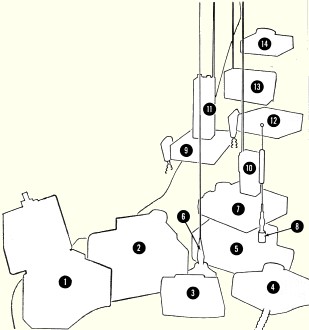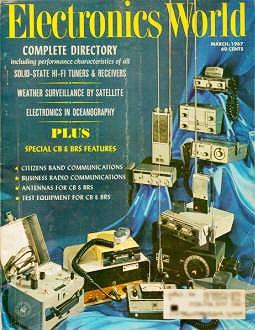|
March 1967 Electronics World
 Table
of Contents Table
of Contents
Wax nostalgic about and learn from the history of early electronics. See articles
from
Electronics World, published May 1959
- December 1971. All copyrights hereby acknowledged.
|
Believe it or not, there are
still radio operators using
Citizen Band (CB) and Business Radio (BR) equipment. That's right,
cellphones (which are themselves radios) have not
totally supplanted traditional radio for person-to-person communications. Prior
to the widespread use of cellphones beginning in the mid-1990s, CB and BR were the
only radios available for use by laymen without an individual license. When I worked
as an electrician between high school and entering the U.S. Air Force, my service
truck was equipped with a radio dispatch transceiver in the
Land Mobile Radio System (LMRS) band. I did not have an FCC license to operate
the radio, but was allowed to communicate under the station license just as I was
able to work as an unlicensed electrician under the purview of the company owner's
Master Electrician license.
Although companies could legally use CB channels (27 MHz) and equipment
at a much lower cost, LMRS permitted power levels were higher (both base and mobile)
with an accompanying greater range. Unlike on the CB channels, competition for voice
traffic was virtually nonexistent. The company I worked for (Simpson Electric Company,
now defunct) had its base station antenna mounted on a 100-foot tower, and many
times I was 40-50 miles away while still able to maintain contact. Unlike with cellphones
that only need to be near one of thousands of cell towers to have messages relayed
to anywhere in the world, LMRS relies on a direct over-the-air link.
Why don't all systems simply migrate to the cellular infrastructure? Simple -
the need for reliability in times of emergency. Remember September 11, 2001, when
Islamic terrorists attacked the Twin Towers, and cell communications on Long Island
was lost for days? LMRS, CB, and Amateur Radio filled the void until cells were
rebuilt. Emergency responder teams and extensive logistical networks (nets) were
enabled thanks to the foresight, planning, and practice by independent operators
- mostly at their own expense.
Citizens Band and Business Radio Equipment
 The group of products on on cover this month
are representative examples of Citizens Band and Business Radio equipment. We have
included a number of transceivers, as well as some test equipment and antennas for
these services. Each product has been keyed with a number to match the descriptions
given in the following paragraphs.
The group of products on on cover this month
are representative examples of Citizens Band and Business Radio equipment. We have
included a number of transceivers, as well as some test equipment and antennas for
these services. Each product has been keyed with a number to match the descriptions
given in the following paragraphs.
(1) International Crystal C-12B frequency meter is a portable secondary frequency
standard designed to service CB transmitters and receivers. The meter comes with
23 crystals installed covering the 23 channels. Frequency accuracy is ± 0.0015%.
The beat-frequency method of frequency checking is used with the difference frequency
between the unit being checked and the crystal standard being counted directly displayed
on a meter. The meter also includes a modulation checker and power-output meter.
(Price: $300)
 (2) Polytronics "Poly-Comm B" and "Poly-Comm
RC-1" are a Business Radio transmitter-receiver unit and a remote-control head for
this unit. This equipment is designed to transmit and receive phase-modulated signals
on one channel in the 27.29 to 35.98 MHz Business Radio band. Plate power input
to the final is 18 W with at least 10 W output. The receiver has built-in squelch
and a sensitivity of better than 0.25 μV for 20-dB quieting. (Price of Model
B is $299.95 and the optional RC-1 is $69.50.)
(2) Polytronics "Poly-Comm B" and "Poly-Comm
RC-1" are a Business Radio transmitter-receiver unit and a remote-control head for
this unit. This equipment is designed to transmit and receive phase-modulated signals
on one channel in the 27.29 to 35.98 MHz Business Radio band. Plate power input
to the final is 18 W with at least 10 W output. The receiver has built-in squelch
and a sensitivity of better than 0.25 μV for 20-dB quieting. (Price of Model
B is $299.95 and the optional RC-1 is $69.50.)
(3) Seco 520-A antenna tester provides direct reading of forward or reflected
power and s.w.r. It is designed for 50-ohm lines and equipment operating in the
3.5 to 160 MHz range. R.f. power is measured directly from 0.5 to 1000 watts on
three scales. The unit does not require external shunts nor correction charts; it
has negligible insertion loss and may be left in the line. (Price: $49.95)
(4) Pace II-S is a 5-watt all silicon transistor CB transceiver. An MOS field-effect
transistor is used for precise frequency control. The double-conversion receiver
has adjustable squelch, a two-step noise limiter, and a signal-strength meter. The
unit can also be used as a portable p.a. system. The transceiver operates from a
12-volt d.c. source with either side grounded. ($179)
(5) Lampkin 105-B frequency meter has a fundamental frequency averaging from
2330 to 2670 kHz, a spread of 1.14 to 1. By means of harmonics and their combinations,
nearby transmitters can be monitored in a continuous range from 100 kHz to 175 MHz.
Radio receivers may also be aligned accurately using the meter as an unmodulated
signal source. Accuracy is guaranteed to be better than 0.002% on all frequencies.
($295)
(6) Antenna Specialists "Mach III" is a base-loaded, shunt-fed, electrical quarter-wave
CB whip antenna. The whip itself is 32 inches long and is made of stainless steel.
A spiral printed-circuit loading coil is suspended inside the sealed base. The antenna
is d.c. grounded. (From $11.20 to $25, depending on hardware.)
(7) E. F. Johnson "Messenger 350" is a solid-state single-sideband CB transceiver.
Either upper or lower sideband on two channels is available for use. Diode switching
is employed rather than mechanical relays. The receiver uses adjustable squelch
and noise silencer. The unit can also be utilized as a public-address system, if
this is desired. ($299.95)
(8) Mosley "Demon" is a short whip antenna designed for CB use. The stainless-steel
whip element is about 14 inches long, over-all height is a few inches more. The
element is center-loaded by means of a coil. ($13.19)
(9) Allied "Knight-kit Safari III" is a 5-watt all silicon transistor CB transceiver
in kit form. Receiver has adjustable squelch, signal-strength meter, and fine-tuning
adjustment for stations that are slightly off channel. A series-gate noise limiter
is also incorporated. Twelve-volt d.c. operation is standard, although a separate
a.c. power supply is available. ($84.50)
(10) Hallicrajters CB-11A is a pocket transportabe transceiver for CB use. It
is completely self-contained, with a battery power supply (ordinary 9-V battery),
built-in dynamic mike and speaker, battery-replacement indicator, and telescoping
antenna. Power input is 100 milliwatts and no license is required for operation.
($74.95 per pair)
(11) Lafayette "Dyna-Com 5" is a 5-watt hand-held CB transceiver. It has three
crystal-controlled transmit and receive channel positions. The superhet receiver
has less than 1-μV sensitivity for 10-dB signal plus noise to noise ratio, and
uses a mechanical filter for high selectivity. An automatic compressor provides
high "talk power" on transmit. Battery pack consists of 12 nickel-cadmium batteries
in a removable holder. ($99.95)
(12) "Heathkit" GW-14 is a solid-state 5-watt CB transceiver. The receiver has
squelch, noise limiting, and a signal-strength indicator. The transmitter, along
with some of the other units shown, features a twin-pi antenna matching network
for high efficiency and low harmonic radiation. Unit operates from 12 V, negative
ground, or from a.c. using accessory power supply. ($89.94 in kit form, $124.95
assembled)
(13) Eico 715 "Trans-Match" is a ham and CB transceiver test set. It can measure
r.f. output power up to 50 watts, standing-wave ratio, modulation percentage, and
field strength. The instrument has a built-in dummy load for power measurements.
($34.95 in kit form, $44.95 assembled)
(14) Amphenol 675 is a 5-watt all silicon transistor CB transceiver. The receiver
is a double-conversion superhet with automatic noise limiting and squelch. Transmitter
uses speech clipping for more "talk power." Like other similar units shown, this
transceiver is quite compact. This unit measures only 2 1/2 inches by 6 1/2 inches
by 9 inches deep. It operates from a 12-V power source. ($179.95)
Posted May 6, 2024
(updated from original post
on 5/22/2017)









 The group of products on on cover this month
are representative examples of Citizens Band and Business Radio equipment. We have
included a number of transceivers, as well as some test equipment and antennas for
these services. Each product has been keyed with a number to match the descriptions
given in the following paragraphs.
The group of products on on cover this month
are representative examples of Citizens Band and Business Radio equipment. We have
included a number of transceivers, as well as some test equipment and antennas for
these services. Each product has been keyed with a number to match the descriptions
given in the following paragraphs. 
